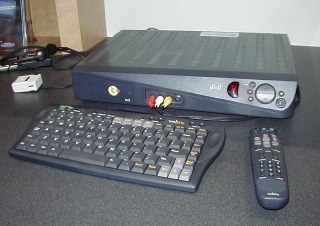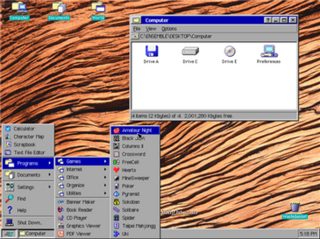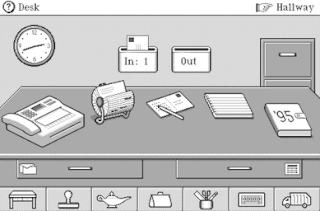
EverQuest is a 3D fantasy-themed massively multiplayer online role-playing game (MMORPG) originally developed by Verant Interactive and 989 Studios for Windows PCs. It was released by Sony Online Entertainment in March 1999 in North America, and by Ubisoft in Europe in April 2000. A dedicated version for Mac OS X was released in June 2003, which operated for ten years before being shut down in November 2013. In June 2000, Verant Interactive was absorbed into Sony Online Entertainment, who took over full development and publishing duties of the title. Later, in February 2015, SOE's parent corporation, Sony Computer Entertainment, sold the studio to investment company Columbus Nova and it was rebranded as Daybreak Game Company, which continues to develop and publish EverQuest.

The PlayStation is a home video game console developed and marketed by Sony Computer Entertainment. It was released in Japan on 3 December 1994, in North America on 9 September 1995, in Europe on 29 September 1995, and in Australia on 15 November 1995. As a fifth-generation console, the PlayStation primarily competed with the Nintendo 64 and the Sega Saturn.

The Compact Disc-Interactive is a digital optical disc data storage format that was mostly developed and marketed by Dutch company Philips. It was created as an extension of CDDA and CD-ROM and specified in the Green Book specifications, co-developed by Philips and Sony, to combine audio, text and graphics. The two companies initially expected to impact the education/training, point of sale, and home entertainment industries, but CD-i eventually became best known for its video games.

Sony Group Corporation, formerly known as Tokyo Tsushin Kogyo K.K. and Sony Corporation (ソニー株式会社), is a Japanese multinational conglomerate corporation headquartered in Minato, Tokyo, Japan. The Sony Group comprises entities such as Sony Corporation, Sony Semiconductor Solutions, Sony Entertainment, Sony Interactive Entertainment, Sony Financial Group, and others.
AIBO is a series of robotic dogs designed and manufactured by Sony. Sony announced a prototype Aibo in mid-1998, and the first consumer model was introduced on 11 May 1999. New models were released every year until 2006. Although most models were dogs, other inspirations included lion cubs, huskies, Jack Russell terriers, bull terrier, and space explorers. Only the ERS-7, ERS-110/111 and ERS-1000 versions were explicitly a "robotic dog", but the 210 can also be considered a dog due to its Jack Russell Terrier appearance and face. In 2006, AIBO was added into the Carnegie Mellon University Robot Hall of Fame.

A light pen is a computer input device in the form of a light-sensitive wand used in conjunction with a computer's cathode-ray tube (CRT) display.

MSN TV was a web access product consisting of a thin client device that used a television for display, and the online service that supported it. The original WebTV device design and service were developed by WebTV Networks, Inc., a company started in 1995. The WebTV product was announced in July 1996 and later released on September 18, 1996. In April 1997, the company was purchased by Microsoft Corporation and in July 2001, was rebranded to MSN TV and absorbed into MSN.

Sony Interactive Entertainment LLC (SIE) is a multinational video game and digital entertainment company owned by Sony. SIE primarily operates the PlayStation brand of video game consoles and products. In 1993, Sony and Sony Music Entertainment Japan jointly established Sony Computer Entertainment Inc. in Tokyo. SCE released the video game console PlayStation in Japan the following year and subsequently in the United States and Europe the year after. In 2010, SCE underwent a corporate split and established Sony Network Entertainment International (SNEI). SNEI provided gaming-related services through the PlayStation Network, including the sale of game titles and content on the PlayStation Store, as well as offering PlayStation Plus. In 2016, SCE and SNEI merged to form Sony Interactive Entertainment LLC, with its headquarters located in San Mateo, California, U.S.

The Nokia 9000 Communicator was the first product in Nokia's Communicator series, announced at CeBIT 1996 and introduced into the market on 15 August 1996. The phone weighed 397 grams (14.0 oz), is powered by an Intel 24 MHz i386 CPU, and has 8 MB of memory. The memory is divided between applications, program memory and user data. The operating system is PEN/GEOS 3.0. The Communicator is one of the earliest smartphones on the market, after the IBM Simon in 1994 and the HP OmniGo 700LX, a DOS-based palmtop PC with integrated cradle for the Nokia 2110 cellular mobile phone, announced in late 1995 and shipped in March 1996.

GEOS is a computer operating environment, graphical user interface (GUI), and suite of application software. Originally released as PC/GEOS, it runs on DOS-based, IBM PC compatible computers. Versions for some handheld platforms were also released and licensed to some companies.
General Magic was an American software and electronics company co-founded by Bill Atkinson, Andy Hertzfeld, and Marc Porat. Based in Mountain View, California, the company developed precursors to "USB, software modems, small touchscreens, touchscreen controller ICs, ASICs, multimedia email, networked games, streaming TV, and early e-commerce notions." General Magic's main product was Magic Cap, the operating system used in 1994 by the Motorola Envoy and Sony's Magic Link PDA. It also introduced the programming language Telescript. After announcing it would cease operations in 2002, it was liquidated in 2004 with Paul Allen purchasing most of its patents.

A handheld personal computer (PC) is a pocket-sized computer typically built around a clamshell form factor and is significantly smaller than any standard laptop computer, but based on the same principles. It is sometimes referred to as a palmtop computer, not to be confused with Palmtop PC which was a name used mainly by Hewlett-Packard.

Heroes of Might and Magic: A Strategic Quest is a turn-based strategy game developed and published by New World Computing in 1995 for DOS. A spin-off of New World Computing's Might and Magic series of role-playing video games, the success of Heroes of Might and Magic led to a number of sequels.
Intellisync Corporation was a provider of data synchronization software for mobile devices, such as mobile phones and personal digital assistants (PDAs). The company was acquired in 2006 by Nokia.

Magic Cap is a discontinued object-oriented operating system for PDAs developed by General Magic. Tony Fadell was a contributor to the platform, and Darin Adler was an architect.

Subnotebook, also called ultraportable, superportable, or mini notebook, was a marketing term for laptop computers that are smaller and lighter than a typical notebook-sized laptop.

A tablet computer, commonly shortened to tablet, is a mobile device, typically with a mobile operating system and touchscreen display processing circuitry, and a rechargeable battery in a single, thin and flat package. Tablets, being computers, have similar capabilities, but lack some input/output (I/O) abilities that others have. Modern tablets largely resemble modern smartphones, the only differences being that tablets are relatively larger than smartphones, with screens 7 inches (18 cm) or larger, measured diagonally, and may not support access to a cellular network. Unlike laptops, tablets usually run mobile operating systems, alongside smartphones.
The 1990s was the third decade in the industry's history. It was a decade of marked innovation in video gaming. It was a decade of transition from sprite-based graphics to full-fledged 3D graphics and it gave rise to several genres of video games including, but not limited to, the first-person shooter, real-time strategy, survival horror, and MMO. Arcade games, although still relatively popular in the early 1990s, began to decline as home consoles became more common. The fourth and fifth generation of video game consoles went on sale, including the Super Nintendo, Sega Saturn, PlayStation, Nintendo 64, and Game Boy Color. Notable games released in the 1990s included Sonic the Hedgehog, Doom, Wolfenstein 3D, Quake, Duke Nukem 3D, GoldenEye 007, Unreal Tournament, Half-Life, Grand Theft Auto, Super Mario 64, Pokémon Red and Blue, Daytona USA, Ridge Racer, Gran Turismo, Castlevania: Symphony of the Night, Super Metroid, The Legend of Zelda: Ocarina of Time, Metal Gear Solid, Virtua Fighter, Final Fantasy VII, Sega Rally Championship, Nights into Dreams, Panzer Dragoon, Gunstar Heroes, Battletoads, Micro Machines, Donkey Kong Country, Wipeout, Lemmings, Banjo-Kazooie, PaRappa the Rapper, Tony Hawk's Pro Skater, Soulcalibur, and Dance Dance Revolution.
The history of tablet computers and the associated special operating software is an example of pen computing technology, and thus the development of tablets has deep historical roots. The first patent for a system that recognized handwritten characters by analyzing the handwriting motion was granted in 1914. The first publicly demonstrated system using a tablet and handwriting recognition instead of a keyboard for working with a modern digital computer dates to 1956.

A smartwatch is a wearable computer in the form of a watch; modern smartwatches provide a local touchscreen interface for daily use, while an associated smartphone app provides management and telemetry, such as long-term biomonitoring. While early models could perform basic tasks, such as calculations, digital time telling, translations, and game-playing, smartwatches released since 2015 have more general functionality closer to smartphones, including mobile apps, a mobile operating system and WiFi/Bluetooth connectivity. Some smartwatches function as portable media players, with FM radio and playback of digital audio and video files via a Bluetooth headset. Some models, called watch phones, have mobile cellular functionality such as making telephone calls.















